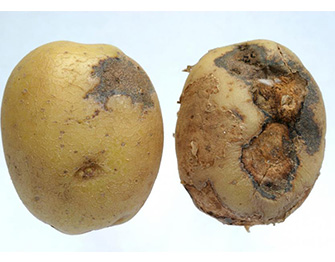Please click here to access the main AHDB website and other sectors.
- Home
- Knowledge library
- Violet root rot
Violet root rot

Violet Root Rot (Helicobasidium purpureum) is a disease of some vegetable crops including potatoes.
Symptoms
Violet root rot is most commonly seen as a blemish on tubers although roots can be affected. Affected tubers can be covered in a fine network of purple mycelia that can join to form a net of thickened strands up to approximately 1mm wide. These strands will be lost on washing but the purple brown microsclerotia will remain in affected patches. The margins of these patches are likely to have ragged edges where skin has been undermined. This skin damage may lead to soft rotting by secondary infection.
Conditions
Violet Root Rot is most often seen in rotations following infected carrots or beet and in alkaline to neutral and sandy soils. Surface tissues of tubers are affected allowing access to secondary soft rots. In extreme cases plants can become chlorotic, wilt and senesce but more commonly there is no sign of the disease until tuber lifting.
Control
There is a wide range of hosts, both crop and weed, making control of certain weeds and volunteers advisable after a problem. Predictably, long rotations are prudent as, even without a host, sclerotia can survive in the soil for several years. Soil movement on machinery could potentially spread an infection from one field to another and consider the risk in planting potatoes after a host crop.

